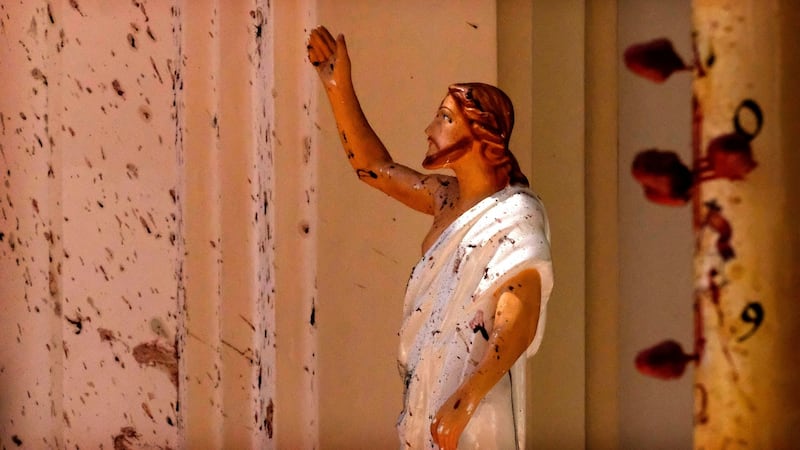Sri Lanka’s past is one that is blood-soaked with violent chapters. On Sunday, another bloody chapter was added to the island’s history.
A country of 21 million people, Sri Lanka shares many similarities with Ireland: the land size, British colonialism and the violent conflicts between different communities are some, but not limited to them. The vicious civil war in Sri Lanka that lasted 26 years between the Sinhala majority community and the Tamil minority community came to an end 10 years ago, leaving more than 100,000 dead.
Sri Lanka has one of the world’s highest number of disappearances, with a backlog of between 60,000 and 100,000 alleged disappearances since the late 1980s stemming from the civil war, but also intra-ethnic episodes of violence. The 10th commemoration of the civil war was scheduled to be held next month.
Sunday’s series of attacks wiped out, at the moment of writing, more than 200 lives and left more than 400 injured. It is too early to determine the perpetrators of this attack. However, it is clear the aim was to wreak havoc on the Christian community on one of the holiest holidays in Christianity.
On Palm Sunday, there were disruptions to the church services and attacks against the Christian community in Anuradhapura. Former United Nations special rapporteur for the freedom of religion Prof Heinz Bielefeldt and former special rapporteur on minority issues Rita Itzsak-Ndiyae had already asserted in 2014 that the growing hostility between the religious communities in the country was of a threatening nature.
‘Atmosphere of impunity’
“[T]his violence is fuelled by the atmosphere of impunity in Sri Lanka. Impunity and inadequate response from the police and judicial authorities aimed at protecting the lives, physical security, the property and places of worship of these communities may encourage further attacks and a risk of spiralling violence . . . The government must end the violence and put in place urgent protective measures to ensure the personal security of all individuals belonging to religious minority communities living in the country.”
After the end of the conflict, the Sri Lankan government had failed to reconcile the different religions and communities. Two inter-religious riots, various inter-ethnic skirmishes, heavy militarisation in the country (especially in the north and the east) are a toxic stew that has further fuelled hostilities.

Numerous attacks against the Muslim, Christian and Tamil communities are recorded in various parts of the country, especially after the end of the war, such as in Selva Nagar, Ginthotha, Wennappuwa. The Bodu Bala Sena (BBS) gained prominence in post-war Sri Lanka and started accusing Muslims of forcing people to convert to Islam and of vandalising religious sites. In 2017 Rohingya refugees from Myanmar were attacked in Sri Lanka, as a crowd, led by BBS, threw stones at a United Nations shelter on the outskirts of Colombo.
Lakshan Dias, a human rights lawyer, was threatened by the country's justice minister to be disbarred over allegedly misleading comments on attacks against places of Christian worship (while he referenced a report according to which 195 attacks were recorded since the current Sri Lankan president Sirisena took office). Against this background, the Sri Lankan police seized a haul of high explosives stashed near a wildlife sanctuary and arrested of four men from a newly formed radical Muslim group in January 2017.
Hallmarks of attacks
Different news media outlets, political commentators and counter-terrorist experts stressed that Sunday’s attacks carry the hallmarks of Islamist terrorism. Whoever the perpetrators, they have contributed to the increasing division between the religious communities, while enabling the nationalist hardliners to seize the public debate.
Sri Lanka has expanded the role of the military since the end of the war. Where the number of the military soldiers was 200,000 at the end of the conflict, it was at 400,000 in 2015. The ratio of soldiers to civilians to soldiers is one to three in the province of Vavuniya. Moreover, according to Human Rights Watch, a "decade after the war, the Sri Lankan army, navy, and air force, as well as the police, continue to occupy private land that is owned and was used by civilians, and state land intended for non-military purposes".
These attacks will provide an opportunity for the Sri Lankan government to further entrench the security narrative. For a country that was, for most of its post-colonial history, ruled by emergency rule, this is no novelty. This security narrative has often helped to serve the interest of the Sri Lankan elite that is hijacked by the Buddhist -Sinhala nationalist ideology.
Sri Lanka is a post-war – but not post-conflict – society. The country’s government needs to conduct an impartial, sober and credible investigation into the attacks. Too often the country failed to offer solutions, preserve human rights and reconcile the different communities. Easter 2019 can eventually be a cathartic moment for Sri Lanka.
Dr Thamil Venthan Ananthavinayagan is a lecturer in international law at Griffith College Dublin









